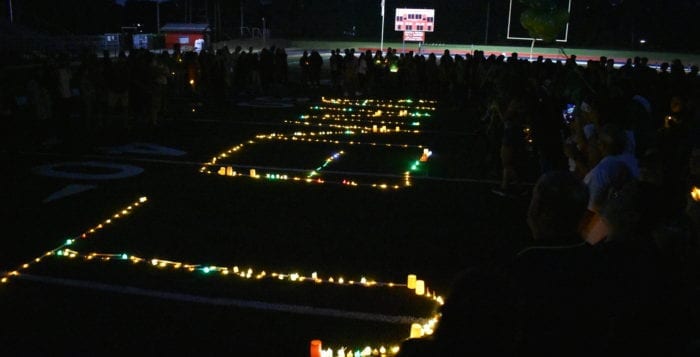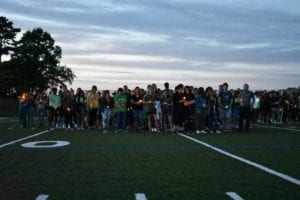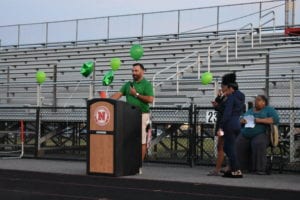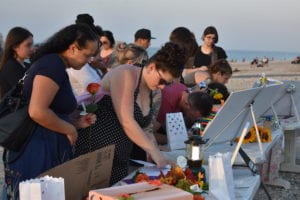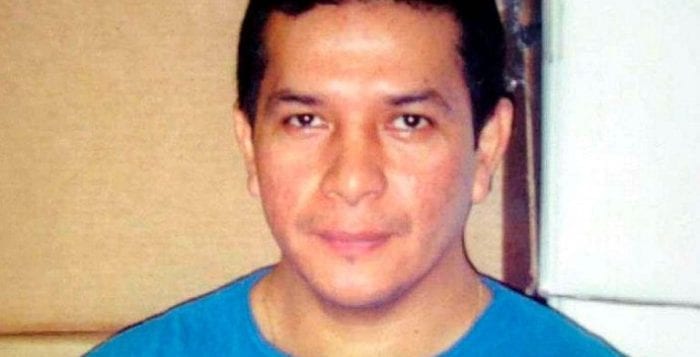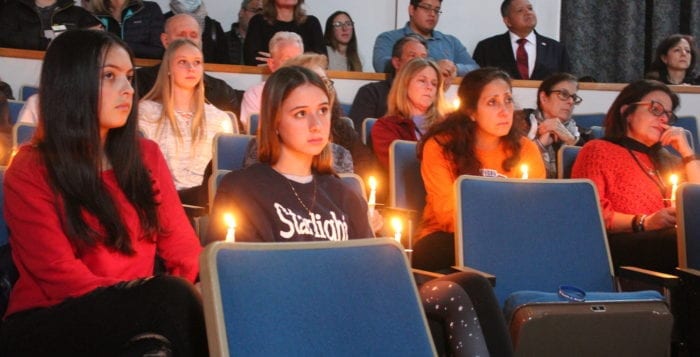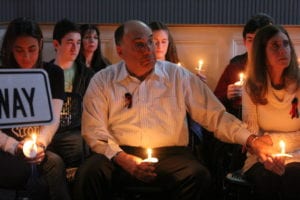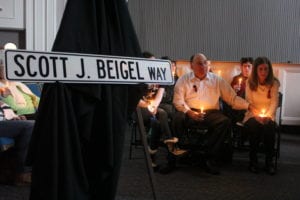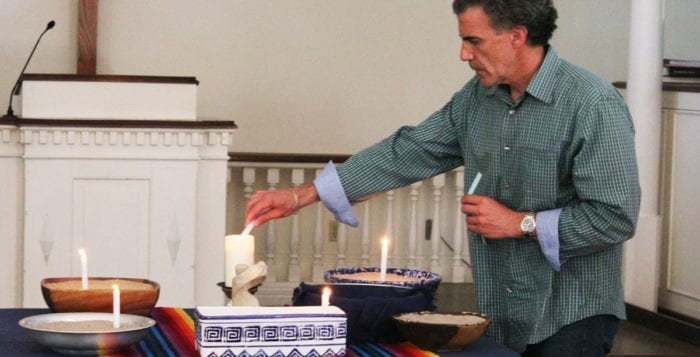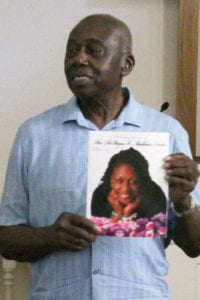By Julie Freedman, M.D.
The shriek of the pager cut through my half-sleep. Willing myself to sit up on the plastic mattress, I pressed my thumbs along my eyebrows to clear a fleeting dream. It was 2:00 a.m. The emergency room had a new patient for me. She was 71 years old and recently diagnosed with amyotrophic lateral sclerosis, or ALS. She was having trouble breathing. After a near-lifetime of dutiful function, the neurons that moved her muscles had simply started to die. Even those muscles we never think about — her diaphragm or the ribbons that lifted her ribs to expand her lungs — had become unreliable. I switched on the fluorescent, call-room light and found my clogs.
Eleanor had a fever. The pneumonia on her X-ray looked like smudged chalk across both lower lungs. The ER physician had started BIPAP — Bilevel Positive Airway Pressure — strapping a cushioned plastic mask tightly over her face, forcing oxygenated air into her mouth. We call this “non-invasive” ventilation, but it is not comfortable. Her vital signs conjured a grim picture — heart racing, breathing fast — but the woman wearing the mask gave a different impression, despite the odd way the machine was ironing out her cheeks with each breath. She was calm. Her unstrained eyes were the chalky blue of flax blossoms. She was feeling better, she mouthed. Actually, she was hungry. Could she eat something?
Her husband, Bill, at her bedside, was calm too. He was tall and trim and moved with a youthful quickness. His neatly-tucked shirt made me suddenly aware of my own pajama-like hospital scrubs. Since Eleanor’s diagnosis, Bill explained, they had been managing everything at home. He was a retired electrician, so he was comfortable with all of the medical equipment. They even had a BIPAP unit there for nighttime.
They had been living close to this edge for some time. It had become normal for her to strap on a mask to breathe. Bill said they wanted to return home as soon as possible. He could handle everything, he assured me, seeming a little irritated by my hovering at Eleanor’s bedside. They had no illusions, he explained, deftly untangling the tangle of wires lying across his wife’s chest. They knew her disease was progressive, and fatal, but they still had things under control.
She was still gardening, he said, with an edge of pride. He showed me a picture of sunlight, caught in the bowls of tulips. Not that life wasn’t messy. It had been messy even before the day Eleanor admitted to him that she could not get her fingers to button her blouse. Bill’s retirement money never quite stretched enough. There were grandchildren to scramble after three days a week. They were sweet kids, but Bill didn’t have the patience. Eleanor did, though. She gave me a stretched-out smile from behind the mask. She was hungry, he reminded me. Was there a sandwich somewhere she could have?
I wasn’t reassured. Her heart was working like she was running up stairs, just to lie still. A patient with weak respiratory muscles and pneumonia in both lungs might soon need the more “invasive” kind of breathing support, a mechanical ventilator. A ventilator blows air into a patient’s lungs through a tube we insert directly into her trachea. Bill and Eleanor hoped to avoid a ventilator, but she would accept it if necessary, at least for a time. To use a ventilator, we would need to sedate and paralyze her, which meant that Eleanor’s stomach should stay empty. So, no sandwich for now.
Over the next two hours, I sat at the ICU nurses’ station across from Eleanor’s room, propped awake by a familiar anxiety, the prickly weight of my own hesitation. If Eleanor’s breathing muscles tired out before the antibiotics took hold, she could quickly worsen. Not intubating her early might endanger her, but it is my nature as a doctor to try to avoid aggressive interventions. I tend to see their burdens in the foreground.
When we intubate someone, we affect a strange transformation. The patient becomes a chimera, part woman and part machine. We lose the expression in her face. The ventilator’s vocabulary of alarms replaces her voice. Her family’s eyes track the cardiac monitor. They touch her skin without knowing if she can feel it. We lose all of the small, animal ways we read each other. A mechanical ventilator can save a life, but when a patient dies despite using one, I struggle to accept what we have done. I was not impartial here. I wanted to get Eleanor back to her tulips and their brief season, but I really did not want to intubate her. So I watched, tracking the cursive of Eleanor’s heart rhythm on the monitor. Eventually, she closed her eyes, her breathing more even, and I returned to my plastic mattress to sleep too.
In the morning, Eleanor smiled brightly when I walked in the room, the only plastic on her face the slender oxygen tubing. Could she finally have breakfast? I was grateful, not sure she grasped the fate she had outrun. Yes to breakfast. Yes, she could. She returned home the following day.
Three months later, Eleanor was back in the hospital with another pneumonia. This one was milder, just some stray sketch lines on her X-ray. At home, she could walk only a few steps now. A truck brought steel oxygen tanks to their house each week. Bill had been half-lifting her, wrapping her arm across his shoulders, to pivot to a portable toilet at her bedside. He had learned some simple cooking because she could no longer manage that, and was getting pretty good at roast chicken. Despite his efforts, Eleanor had lost weight. The space between the bones of her forearm was a furrow under my fingers. Each day though, she spent time in their garden. There was a shady spot for her wheelchair.
Eleanor did not seem to defy her medical numbers this time. She looked weary as her heart jogged along. Her thin shoulders kept slumping leftward despite the pillows that the nurses had tucked around her. I was at her bedside on her third hospital day when she took a sip of water and started to choke.
She coughed again and again, a flash of the pale blue of her eyes each time, then finally recovered. She began to cry. “I’m sorry. I’m sorry,” she said.
She shouldn’t be like this, she explained. Anger ridged her quiet voice. She was supposed to make cookies with her smallest granddaughter. The girl was four. What would she remember? This being lifted to the toilet, this fragility, it did not suit her. She was a mother and a grandmother. She stirred thick dough and weeded and bound her family together. Except that now, she did not. I had focused on her vital signs. I was missing her suffering. I sat and held her papery hand and told her that none of this was her fault.
The next day, Eleanor was stable enough to return home. Busy with other patients, I sped by her room for a quick hug, taking in the sharp ridge of her shoulder against my chest.
Two months later, she returned. At home, she was in bed all the time. Her neurologist had actually sent two hospice nurses to the house a few weeks before. They set up an array of syringes and tablets in the dining room. Bill sent them away again after only two days. He didn’t like how they did things. Those nurses had brought morphine. They had started to teach Bill to administer it. That had scared them both. “We don’t believe in morphine,” Bill told me. Eleanor, watery-eyed behind her oxygen mask, nodded agreement. She pointed to a spiral-bound notebook and I handed it to her. In shaky letters, all capital, she wrote, “I WANT CONTROL.”
It’s not often that patients tell me that they “don’t believe” in a medication, but morphine can spark intense reactions. I fell silent, trying to resolve what it was they did not believe in. Eleanor’s thin legs barely rippled the hospital blankets. Breathing itself was work. Both she and Bill knew she was dying. What did “control” mean for her now?
The pharmacology of morphine is complex. It is an essential medicine at the end of life. It relieves pain, and, because there are opiate receptors in the lungs, also soothes the drowning feeling that comes with end-stage respiratory illness. I remembered Eleanor choking on that thread of water. If she felt that again, morphine would help. But it is an imprecise drug. It causes sedation as it relieves physical suffering. Was this the loss of control she feared? It can also cause euphoria, restlessness, hallucinations, and, at high doses, death. My training taught me to show it due respect: start with low doses, lower still for someone frail, then assess for effect.
Medical ethics teaches that intention matters. If I give a reasonable dose of morphine with the intention to relieve suffering, and I cause an unwanted outcome — sedation or agitation, or even death — I am still keeping my oath not to harm. This is the “doctrine of double effect,” derived from the teachings of 13th-century Catholic theologian Thomas Aquinas. It offers a clear enough theory, but it never really sets me at ease. If I give a drug and a bad thing happens, my patients and their families experience that bad thing. I have hurt them, and Aquinas does not offer much comfort.
To be clear, morphine relieves suffering almost all of the time. Patients usually welcome that relief, but I’ve also spoken with grieving family members who look back on someone’s death from a long, terrible illness, convinced that morphine was the thing that killed her. These conversations play in my mind when I care for a dying patient in the hospital. I am aware of the family’s eyes on my hands, of how my words might replay in their heads, that they will relive my patient’s last moments again and again. In this sense, the family becomes my patient too.
Eleanor’s words on that notebook page were wildly impossible: she did not have control. They seemed like a request for relief that I was not trained to give, spiritual or existential. Eleanor and Bill had faced her illness by asserting control in the face of the uncontrollable. They voiced acceptance, but they were defiant. All along, they had been letting out rope, in stepwise retreat, giving up the gardening, the cooking, the not needing help. With each retreat, they had established another defensive position, and now she was staked out at just remaining awake. Eleanor’s cardiac monitor alarmed in shrill tones as her heartbeat became briefly irregular, then quieted. I dropped the subject of morphine for the moment. I could not find words to resolve Eleanor’s desire for control with how near she was to death. I didn’t want to push anything on them that they might later look back on as a violation.
A few hours later, Eleanor was struggling. There was sweat on the sides of her nose. I tentatively asked her if she would accept some morphine to help ease her breathing. She nodded. I ordered a small dose, and returned to the room with the nurse while she gave it. I talked with Bill and with Laura, their daughter, consciously modeling a sense of calm routine. The drug helped. Eleanor’s face relaxed. She even gave a hint of a smile.
That evening, Eleanor was mostly peaceful. When she did become uncomfortable, she received more morphine, and was able to rest. The next morning, Bill asked me about bringing her home. She wanted to see her garden. He wanted her there too.
As we talked, Eleanor began to cough, nearly silently. Her shoulders jerked. She lurched her hand clumsily for Bill’s wrist. Her nurse gave morphine. Ten minutes later, she was still breathing fast, grunting, heavy eyelids startling open with each cough. Bill sat down, then stood again, then sat. He reached to adjust her monitor wire, her oxygen cannula, then stopped, suddenly unsure of where to put his hands. Laura reached for Eleanor’s shoulder. I asked her nurse for another dose of morphine. A few minutes passed. Eleanor’s breathing quieted and she leaned her face into a pillow. Bill let out a long breath, then turned to me. He began to ask about the logistics of ambulance transportation home.
Suddenly, Laura nudged her father. Eleanor’s eyes had closed, and her breathing pattern had changed. With each inhalation, she lifted her chin up and forward, like a swimmer reaching for the surface of the water. Bill called her name. She didn’t answer. Suddenly, she was gone from in front of us. Bill looked at me, eyes flashing something that might have been anger. My own heart pounded. I knew the morphine doses had been appropriate. Still, I worried he might hold me accountable if these were her final moments. Willing myself calm, I encouraged them to stand close to her, to hold her hands and touch her hair and talk to her. After a few minutes, I left them alone.
An hour passed. I crept back to her room, but hesitated before parting the polyester curtain. My patients are usually strangers to me, but Eleanor was not. It was an accidental gift of my call schedule that had let me care for her through her three hospitalizations, to watch over her and her family, even in this interrupted way. I was afraid I had failed them anyway. Gathering a breath, I went in. More family members had arrived, seven in all. At the center of this crowd, awake and laughing, was Eleanor. She had spent fifteen minutes beyond the reach of their voices, and then woke up to find them staring at her. She had jokingly asked for lipstick so she could face the occasion more glamorously. They were almost giddy with relief. But relief for what? Relief that she had not died, certainly, but she would soon and they all knew it. They now knew what her death could be like. They had had their dress rehearsal, and, in the extinction of that mystery, it was like they no longer feared it. Suddenly, they had these minutes, and maybe hours or even days, and each one was a gift.
Eleanor was too fragile to send home. Laura and Bill would instead stay with her overnight. She struggled briefly that evening, but by sunrise, she was mostly dozing. A few hours later, her breathing slowed. Again, she reached her chin upward for air. Again, she was beyond the reach of her family’s voices. I counted to 20 after one breath ended before the next one came. And then, none came. Bill wept. “My girl,” he said, taking her hand.
Julie Freedman is a hospitalist and palliative care physician at a community hospital in the San Francisco Bay Area. She received her medical degree from Harvard University and trained in internal medicine at the University of California, San Francisco. She believes that we need narrative almost as we need shelter: We build stories around ourselves in the face of serious illness. Understanding, and sometimes entering, these stories is an essential part of caring for patients. On the other hand, after this last year, she is thinking it might also be lovely to become a florist. She is on Twitter @jfreedmanmd
* This article was first published in the Spring 2021 Intima: A Journal of Narrative Medicine (theintima.org) and is reprinted with permission.


